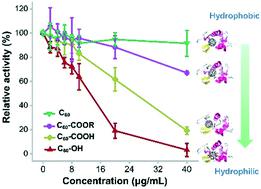当前位置:
X-MOL 学术
›
Environ. Sci.: Nano
›
论文详情
Our official English website, www.x-mol.net, welcomes your
feedback! (Note: you will need to create a separate account there.)
Surface modification mediates the interaction between fullerene and lysozyme: protein structure and antibacterial activity
Environmental Science: Nano ( IF 5.8 ) Pub Date : 2020-10-13 , DOI: 10.1039/d0en00645a Yitong Bai 1, 2, 3, 4, 5 , Xian Wu 1, 2, 3, 4, 5 , Peng Ouyang 1, 2, 3, 4, 5 , Mengyao Shi 1, 2, 3, 4, 5 , Qun Li 1, 2, 3, 4, 5 , Tusunniyaze Maimaiti 1, 2, 3, 4, 5 , Suke Lan 1, 2, 3, 4, 5 , Sheng-Tao Yang 1, 2, 3, 4, 5 , Xue-Ling Chang 5, 6, 7, 8, 9
Environmental Science: Nano ( IF 5.8 ) Pub Date : 2020-10-13 , DOI: 10.1039/d0en00645a Yitong Bai 1, 2, 3, 4, 5 , Xian Wu 1, 2, 3, 4, 5 , Peng Ouyang 1, 2, 3, 4, 5 , Mengyao Shi 1, 2, 3, 4, 5 , Qun Li 1, 2, 3, 4, 5 , Tusunniyaze Maimaiti 1, 2, 3, 4, 5 , Suke Lan 1, 2, 3, 4, 5 , Sheng-Tao Yang 1, 2, 3, 4, 5 , Xue-Ling Chang 5, 6, 7, 8, 9
Affiliation

|
Chemical functionalization is widely adopted to increase the hydrophilicity of fullerene for various applications. Protein–nanomaterial (NM) interactions are one of the very first issues after NMs enter biological systems, which determines their bio-effects and toxicity. To better understand the biological and environmental effects of fullerene, we investigated the influence of surface modification on the fullerene–protein interaction by experimental and computational approaches. Pristine fullerene (C60) was functionalized to obtain esterified fullerene (C60–COOR), carboxylated fullerene (C60–COOH) and fullerenol (C60–OH), resulting in higher hydrophilicity and dispersibility following the sequence C60–OH > C60–COOH > C60–COOR > C60. The docking results suggested that good hydrophilic functionalization largely reduced the π–π interaction between aromatic residues and the fullerene cage, resulting in a weaker interaction between fullerene and lysozyme. Experimentally, the chemically functionalized fullerene showed more inhibition of enzyme activity. Correspondingly, the protein conformation changed more after incubation with functionalized fullerene with hydrophilic moieties (C60–COOH and C60–OH), indicated by the increased UV absorbance, the inhibition of intrinsic fluorescence and the loss of the α-helix structure. The contradictory results of computational and experimental approaches were attributed to the different dispersibilities, where functionalized fullerene with hydrophilic moieties dispersed well in aqueous systems to reach the lysozyme active pocket more easily. As a direct bio-effect, the dispersible fullerenes inhibited the antibacterial activity of lysozyme, which might affect the resistance to infection and the applications of lysozyme in biomedicine, food and bioengineering. Our findings suggested that surface modification should be carefully designed to obtain safer carbon NMs and enough consideration should be paid to the protein–nanomaterial interaction in environmental toxicity evaluations.
中文翻译:

表面修饰介导富勒烯与溶菌酶之间的相互作用:蛋白质结构和抗菌活性
化学官能化被广泛采用以增加富勒烯在各种应用中的亲水性。蛋白质-纳米材料(NM)的相互作用是NMs进入生物系统后的第一个问题,它决定了它们的生物效应和毒性。为了更好地了解富勒烯的生物学和环境影响,我们通过实验和计算方法研究了表面改性对富勒烯与蛋白质相互作用的影响。对富勒烯(C 60)进行官能化处理,以获得酯化富勒烯(C 60 -COOR),羧化富勒烯(C 60 -COOH)和富勒烯醇(C 60 -OH),从而按照顺序C 60获得更高的亲水性和分散性-OH> C 60 -COOH> C 60 -COOR> C 60。对接结果表明,良好的亲水性官能化大大降低了芳族残基与富勒烯笼之间的π-π相互作用,从而导致了富勒烯与溶菌酶之间的相互作用较弱。实验上,化学官能化的富勒烯对酶活性的抑制作用更大。相应地,在与具有亲水性部分(C 60 –COOH和C 60-OH),通过增加的紫外线吸收,固有荧光的抑制和α-螺旋结构的丧失来表明。计算和实验方法的矛盾结果归因于不同的分散性,其中具有亲水性部分的官能化富勒烯很好地分散在水性体系中,从而更容易地达到溶菌酶活性口袋。作为直接的生物效应,可分散的富勒烯抑制了溶菌酶的抗菌活性,这可能影响其抗感染性以及溶菌酶在生物医学,食品和生物工程中的应用。我们的研究结果表明,应谨慎设计表面修饰以获得更安全的碳纳米管,并且在环境毒性评估中应充分考虑蛋白质与纳米材料之间的相互作用。
更新日期:2020-12-17
中文翻译:

表面修饰介导富勒烯与溶菌酶之间的相互作用:蛋白质结构和抗菌活性
化学官能化被广泛采用以增加富勒烯在各种应用中的亲水性。蛋白质-纳米材料(NM)的相互作用是NMs进入生物系统后的第一个问题,它决定了它们的生物效应和毒性。为了更好地了解富勒烯的生物学和环境影响,我们通过实验和计算方法研究了表面改性对富勒烯与蛋白质相互作用的影响。对富勒烯(C 60)进行官能化处理,以获得酯化富勒烯(C 60 -COOR),羧化富勒烯(C 60 -COOH)和富勒烯醇(C 60 -OH),从而按照顺序C 60获得更高的亲水性和分散性-OH> C 60 -COOH> C 60 -COOR> C 60。对接结果表明,良好的亲水性官能化大大降低了芳族残基与富勒烯笼之间的π-π相互作用,从而导致了富勒烯与溶菌酶之间的相互作用较弱。实验上,化学官能化的富勒烯对酶活性的抑制作用更大。相应地,在与具有亲水性部分(C 60 –COOH和C 60-OH),通过增加的紫外线吸收,固有荧光的抑制和α-螺旋结构的丧失来表明。计算和实验方法的矛盾结果归因于不同的分散性,其中具有亲水性部分的官能化富勒烯很好地分散在水性体系中,从而更容易地达到溶菌酶活性口袋。作为直接的生物效应,可分散的富勒烯抑制了溶菌酶的抗菌活性,这可能影响其抗感染性以及溶菌酶在生物医学,食品和生物工程中的应用。我们的研究结果表明,应谨慎设计表面修饰以获得更安全的碳纳米管,并且在环境毒性评估中应充分考虑蛋白质与纳米材料之间的相互作用。











































 京公网安备 11010802027423号
京公网安备 11010802027423号